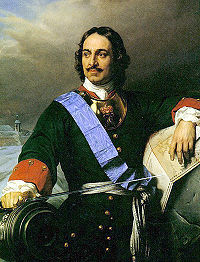The concepts covered in this factsheet go beyond those seen in secondary school. It is intended as a supplement for those who are curious to learn more.
The word tsar is derived from the word caesar, a title traditionally reserved for the emperor of Byzantium. The title of tsar confers on leaders a status similar to that of emperor.
Several sovereigns played the role of tsar between 1547 and 1917, including Ivan IV and Alexis 1st
The first Russian sovereign to be crowned tsar was Ivan IV, in 1547. The reign of Ivan IV was marked by an expansion of the territory towards the east. Nicknamed Ivan the Terrible, the first tsar managed the country despotically. It was Ivan IV who introduced the system of serfdom over land. Under this system, landowners took advantage of the serfs (peasants) who were in their service.
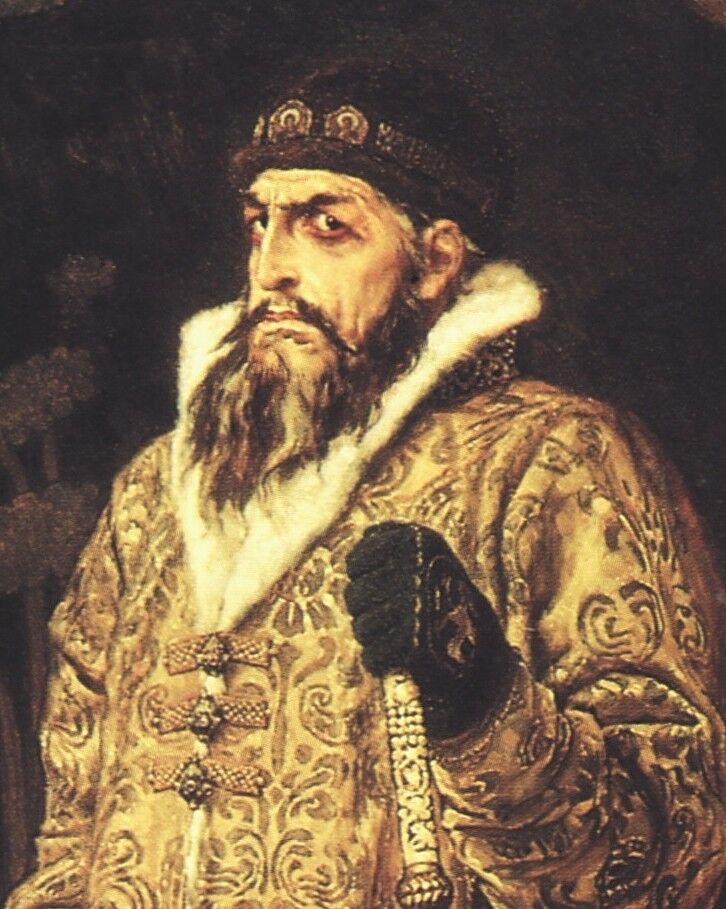
Ivan IV
Ivan the Terrible divided the country in two and even forced the displacement of populations, which led to many problems in the country. The end of Ivan IV's reign also brought a period of turmoil, with false tsars taking power, popular revolts and foreign invasions.
The Romanov dynasty took power in 1550 and held it until the end of the Tsarist era.
In the 17th century, Alexis 1st came to power. It was he who published Russia's first printed code in 1648. This code confirmed the system of serfdom by recognising the superiority and power of the nobility over serfs and peasants. This code thus set the social rules that were to be the hallmark of the Tsarist regime. However, the code had negative repercussions, leading to numerous peasant revolts. The reign of Alexis 1st was also marked by social unrest caused by religious disputes between reformers and traditionalists.
The 18th century in Russia was marked by numerous transformations (territorial and social). The two most important tsars of the century were Peter the Great and Catherine II. Their respective reigns were interspersed with a singular period: the Tsarina Spring.
The reign of Peter the Great was marked by the tsar's relentless efforts to bring Russia closer to Europe. Peter the Great's aim was to Europeanise Russia so that it could be considered a European state like any other. To achieve this, Peter the Great considerably increased the tsar's autocratic power. Following the French model established by Louis XIV, Peter the Great wanted to create the illusion of a centralised, civilised state.
For a long time, Russia had operated under a patriarchal regime: power was marked by respect for paternal authority at every level, even in politics. This patriarchy influenced relations between the Tsar and his subjects, between fathers and their children, between owners and their slaves - in short, between superiors and inferiors. Peter the Great did not invent this patriarchal structure, but he certainly reinforced it.
In order to Europeanise the country, the Tsar had to impose several reforms by force and bloodshed. The main aim of all the reforms was to increase the Tsar's strength and power and provide Russia with institutions similar to those that already existed in Europe: a regular army, a bureaucratic hierarchy, industries, schools, academies, a Senate, administrative colleges, a school of cartography and so on. Peter the Great wanted to give autocracy a new face with more modern and effective political tools.
All these changes were made possible by the regular communications established with Europe and the newly created maritime links. Throughout his reign, Peter the Great visited the major European cities, exploring their structures and recruiting for positions in his new army. It was thanks to this new army that Peter the Great was able to launch Russia on a series of territorial conquests that would give his country an important political position. It was also Peter the Great who founded a brand new city in June 1730: St Petersburg. This new capital would serve above all as a link with Europe.

Petrdvoret Palace, built at the request of Peter the Great
The opening up of Europe was not only due to military or commercial ideas. European ideas also influenced education and culture. Peter the Great used texts and made political choices to promote new ideas and propagate new practices. As far as education was concerned, the Tsar made education compulsory for all the sons of nobles and priests and founded a number of elementary schools.
He imported European ideas to Russia through the translation of numerous literary and formal texts. In addition to literary texts, he had works on history, geography, politics, economics, navigation, military science, agriculture, linguistics, etc. translated. Some translations were intended to introduce the rest of Europe to the Russian Reformation, while others were intended to introduce Russia to Europe. Peter the Great perfected the printing process, which he used as a propaganda tool, encouraging, among other things, the creation of the Russian Gazette in St Petersburg.
This period was marked by a rapid succession of leaders, most of whom were women. The death of Peter the Great gave rise to a serious succession crisis, as he had not had time to name his successor before his death. This historic period is known as the Tsarina Spring.
On the death of Peter the Great, Catherine I, the widow of the deceased tsar, assumed power. During her two-year reign, she attempted to continue the modernisation of Russia begun by Peter the Great.
Peter II's reign was short-lived. What's more, when he was appointed Tsar, he was still too young to really govern. That's why he let members of the nobility make the decisions for him. While he was in power, several decisions were taken to strengthen the Tsar's control over the magistrates and to increase the Senate's role in political decision-making. He died of smallpox at the age of 15.
Anna Ivanovna, niece of Peter the Great, became empress on the death of Peter II. However, at the beginning of her reign, she had to contend with a few nobles who wanted to force her to comply with their demands. These demands mainly involved limiting the Tsar's power.
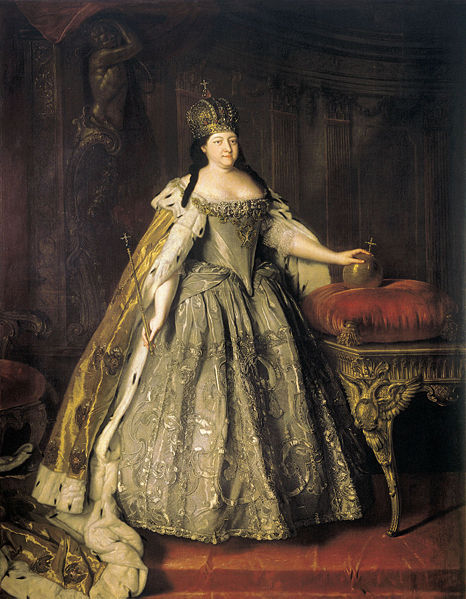
Anna Ivanovna
Anna Ivanovna ignored these demands and established autocratic power. Not managing political affairs herself, she delegated them to a few ministers who established a regime of terror. Most of Anna Ivanovna's advisers came from abroad.
After the death of Anna Ivanovna, the young Ivan VI was proclaimed the new Tsar. Only a few months old, the young Tsar did not govern. The regency was left to Anna Ivanovna's former minister. This regency did not last long and was taken over by Yvan VI's mother. Rather like Anna Ivanovna, Yvan VI's mother drew her inspiration from German regimes and it was mainly the ministers who ran the country. A coup d'état in 1741 removed Yvan VI and his mother from power. The public preferred a less German and more Russian leader. Ivan VI was sent to prison until 1764, when another coup attempted to restore him to power. Ivan VI died during this attempt, murdered by his jailers.
A jailer is a person who watches over prisoners, a prison guard.
Elizabeth 1st was the Tsarina whom the leaders chose to put on the throne to replace Ivan VI. The daughter of Peter the Great and Catherine I, she managed the country in a calmer context. It was Elisabeth 1st who initiated a movement to open up to French culture.
When he died, the problem of finding a successor arose again, as Peter III was assassinated. The problem of succession was resolved when Catherine II came to power.
The last tsarina in the history of Russia, Catherine II's long reign was strongly influenced by French culture. Throughout her life, the Tsarina kept up a correspondence with Voltaire. Presenting herself as a friend of the philosophers, she wanted to give her country an image of openness and change. However, this image was spread mainly through propaganda. In reality, the reign of Catherine II was very hard, as life for the Russian people was very difficult. Several revolts were put down in bloodshed.
During her 33-year reign, Catherine II used favouritism to place the people she wanted in important positions. The tsarina's aim was to match the West. She introduced an income tax on ecclesiastical property, founded a bank and an economic company, introduced potato cultivation in Russia, opened new hospitals and succeeded in attracting many foreigners.
To facilitate the management of the country, Catherine II divided the country into 50 governments, themselves divided into districts. These governments were supplemented by judicial and financial institutions. In 1785, Catherine II created new powers, allowing the nobility to form provincial assemblies and the bourgeoisie to organise municipalities. However, the peasants seemed to have been forgotten, as they got nothing out of this reform.
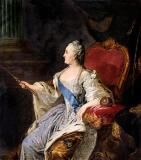
Catherine II
The Tsarina drew up a complex plan to structure national education : asylums, small schools, large schools and universities. In concrete terms, she succeeded in founding a number of secondary schools, creating a cadet corps and founding the Russian Academy. She also worked very hard to develop Russian literature. As a result, she wrote many texts: political texts, fairy tales, comedies, operas, newspaper articles and accounts of Russian history.
Her reign was not unanimous. His decisions regarding the division of power aroused the discontent of the people and the clergy. This discontent was exacerbated when the plague broke out among the population. What's more, with the numerous wars aimed at expanding the territory, the state coffers were increasingly empty. Despite this, Catherine succeeded in considerably expanding Russia's territory and putting the country on the map in Europe.
The reign of Catherine II was followed by that of Paul I. Catherine II's son was tsar for 3 years and died in a coup d'état.
Catherine II's young son, Alexander 1st, was the successor the Tsarina had wanted. The reign of Alexander 1st is often associated with that of Napoleon, as the two rulers reigned almost simultaneously. They are also known to have fought several wars and battles against each other.
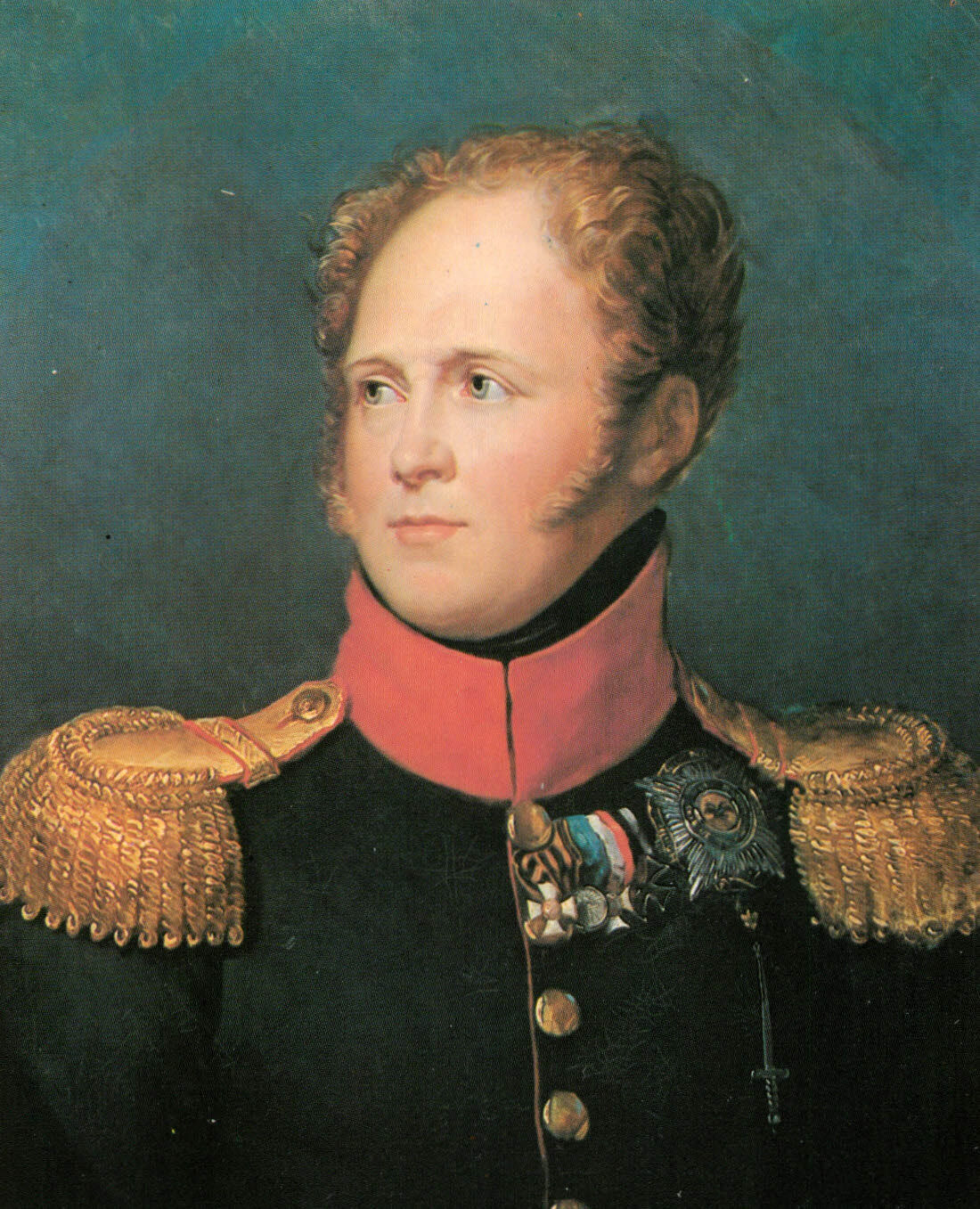
Alexander 1st
Raised in the French style, Alexander 1st drew up a draft constitution. He also wanted to grant new rights to the Senate. From 1814, Alexander developed a mystical crisis that led him to convert to a kind of Methodism, the Bible Society, under the influence of Baroness von Krüdener. He remained in power until his death in 1825. Some people doubt his death and have developed a theory of subterfuge. Some people claim that Alexander 1st went into exile after pretending to be dead. However, there is no proof of this.
The end of Alexander 1st's reign was also disrupted by another event. The Decembrist Revolt involved a group of people demonstrating for a real constitution. On 14 December 1825, a group of officers incited their men to revolt. As a result of these events, 36 people were sentenced: 5 were executed and 31 sent to forced labour.
Nicholas 1st was crowned after a period of instability marked by the Decembrist revolt and the death of the Tsar in rather strange circumstances. From the start of his reign, he feared another revolution, which is why he was very conservative and governed by keeping a tight rein on the people.
He set up a system of censorship in which he monitored the activities and writings of intellectuals and academics, controlled the entry of foreign works, limited exits from Russian territory, established a strong political police force, banned the teaching of philosophy and constitutional law and bequeathed strong centralising power to the Orthodox Church. His main struggle was to violently oppose the nationalist and revolutionary movements taking place elsewhere in Europe. It could be said that this was the Russia of Nicholas 1st against all revolutions.

Nicholas 1st
Nicholas 1st also distanced himself from the West by emphasising the national genius and virtues of the Russian people. His political regime was highly repressive and his foreign policy was uncompromising, autocratic, nationalist and Orthodox. The end of his reign was marked by Russia's defeat by the coalition formed by the Ottoman Empire, Great Britain and France.
A Life for the Tsar is a Russian opera composed by Mikhail Glinka in 1836. The opera draws heavily on the legend of Ivan Soussanine, a Russian national hero. This legend was used by the Tsars for propaganda purposes.
Following this great defeat, the new Tsar, Alexander II, introduced a policy of reform. Among other things, he began by abolishing the serfdom policy and then developing local freedoms (election of provincial assemblies with real local powers).
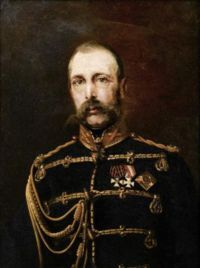
Alexander II
He also reorganised the judiciary to make it more independent of the Tsar's power. He made education accessible to all social classes and eased censorship of the press and publishing. However, Alexander II was assassinated by revolutionaries in 1881, after surviving several attempts on his life.
Alexander III adopted a very different policy from that of his father, Alexander II. After the assassination of the latter, Alexander III returned to an autocratic policy and put an end to reforms and revolutions. In order to ensure that no revolution would be attempted again, Alexander III applied numerous repressive measures: he wanted to re-establish serfdom, he limited the powers of the institutions created by his father, he forced orthodoxy on the conquered territories, he increased the surveillance of intellectuals, and so on.
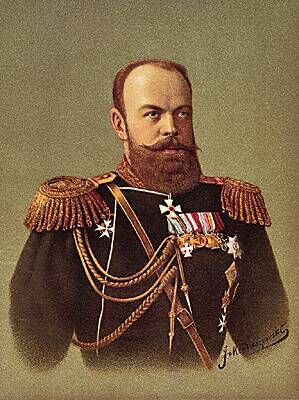
Alexander III
Despite these repressive decisions, Alexander III's reign was peaceful, as no major wars broke out. The Tsar even forged a new rapprochement with France and signed treaties. This is why Alexander III is sometimes nicknamed the Peacemaker.
Following in the footsteps of his predecessor, his father Alexander III, Nicholas II maintained a traditional policy. Taking advantage of the good relations established between France and Russia, Nicholas II took part in the first World Peace Convention. Where Nicholas II wanted to extend his power was in the Far East, where Russia was forced to capitulate. The people, unhappy with this defeat, took part in revolutionary movements that led to the 1905 revolution.

Nicholas II
A workers' demonstration ended in bloody police repression. This repression, instead of dampening the revolutionary movements, launched the country into a period of instability: increased repression, strong strike movements. At the same time, the Industrial Revolution required more and more workers, all of whom were recruited from the peasantry. These peasants, who played a major role in the country's economy, were not recognised and became increasingly dissatisfied.
The revolt grew even stronger with the outbreak of the First World War, in which mainly peasants and workers were sent to serve. Almost 2 million Russian peasants did not survive the war. The revolutionary movement continued to spread throughout Russia while the leaders were occupied with the global conflict. Popular tension mounted and acts of mutiny linked to the revolution continued to increase. The Tsar had no choice but to abdicate on March 2nd 1917. A few months later, in July 1918, the Tsar and his family were assassinated, marking the end of the Tsarist regime. Vladimir Lenin took power.
The city of St Petersburg was founded in 1703 by Tsar Peter the Great. Strongly influenced by European culture, the Tsar wanted to give Russia a capital similar to the major European cities.
Founded near the sea in the west of the country, the city is at the centre of a region that floods easily. As a result, the ground in St Petersburg is waterlogged. Nevertheless, Peter the Great succeeded in creating the city as he had imagined it. He also succeeded in building St Samson's Church in 1709 by forcing some 40,000 workers to work there. These forced shipments of workers continued over the next 3 years. By 1714, the population of St Petersburg had already risen to 150,000 and the city contained 34,500 different buildings. To ensure this large population, Peter the Great offered buildings free of charge to the people and ordered the nobles to settle in his future capital.
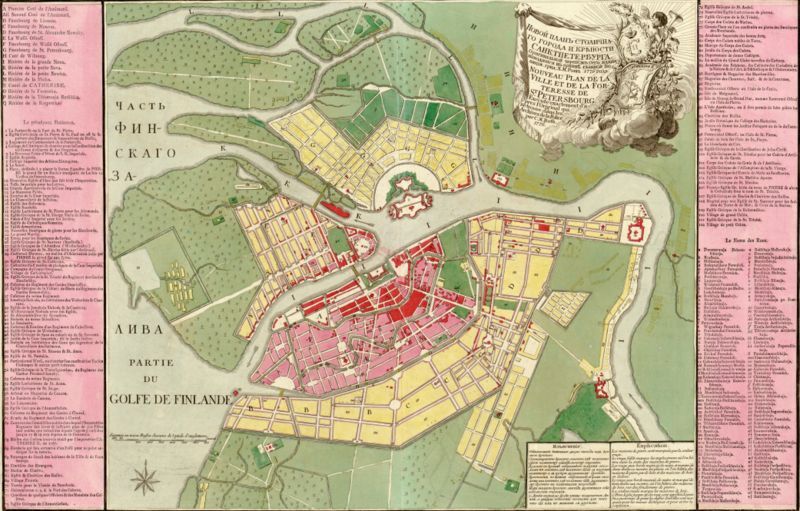
Map of St Petersburg in the mid-18th century
Thanks to its geographical location, St Petersburg plays an important role in trade, despite the risk of flooding. In addition to his commercial activities, Peter the Great developed a city with grandiose monuments and public buildings: impressive architecture, rich decoration, beautiful public squares, works of art, etc. The architectural style was more influenced by European than Russian culture.
Peter the Great's real ambition in founding this new city was to make it the new capital of Russia. In fact, the city was only the capital between 1712 and 1718. After the fall of the Tsarist regime, Lenin named Moscow as the capital.
St Petersburg has not always kept the same name throughout history. First, during the First World War, the city was renamed Petrograd. After Lenin's death in 1924, the city once again changed its name to Leningrad. This name remained until 1991, when St Petersburg reverted to its original name. Today, St Petersburg is known as the Venice of the North because of the many streams and canals that run through the heart of the city.
The historic centre of St Petersburg was added to UNESCO's World Heritage List in 1990. This historic centre includes numerous canals, no fewer than 400 bridges, numerous buildings constructed under the orders of Peter the Great and the Hermitage Museum.

Panoramic view of St Petersburg at the end of the 19th century
The Hermitage Museum
One of St Petersburg's most imposing monuments is the Hermitage Museum. Consisting of 5 historic buildings, the Hermitage is located near the port of St Petersburg and close to the River Neva.

The Hermitage Museum buildings, seen from the river
The main building of the Hermitage is the Winter Palace, the former residence of the Tsars for the cold season, which was built between 1754 and 1762 under the orders of Tsarina Elisabeth. All the buildings in the Hermitage were constructed between the 18th and 19th centuries and were designed by the best European architects of the time. The Hermitage thus reflects an architecture that is sometimes Baroque, sometimes neoclassical.
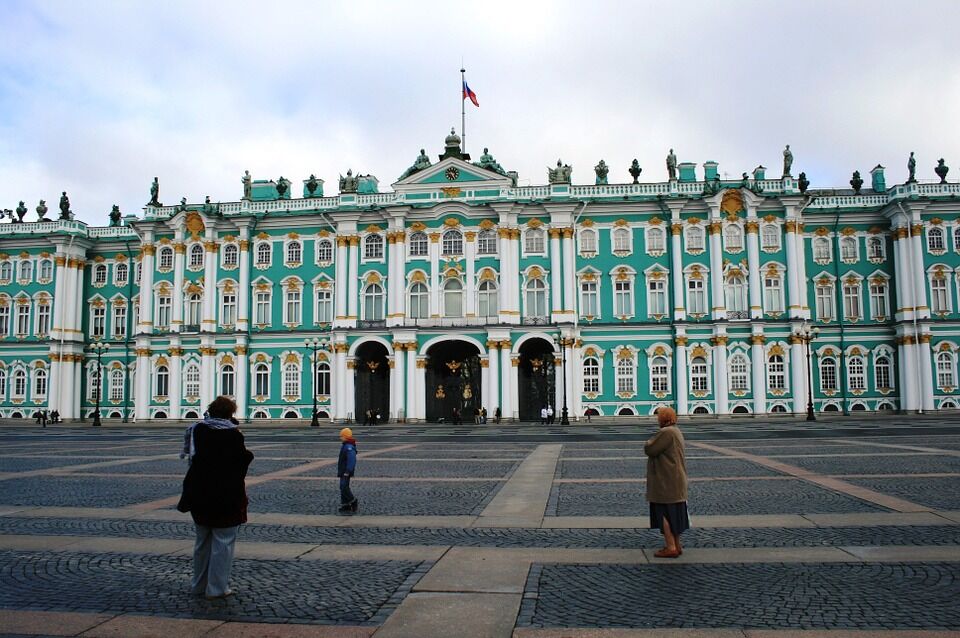
Front facade of the Winter Palace
During the reign of Catherine II, the city of St Petersburg was truly an important cultural capital, as the Tsarina had made it the city of the arts. To this end, she had a new section built, which she herself nicknamed the Hermitage. In this new room, which she used to receive her guests, she exhibited an impressive collection of paintings.
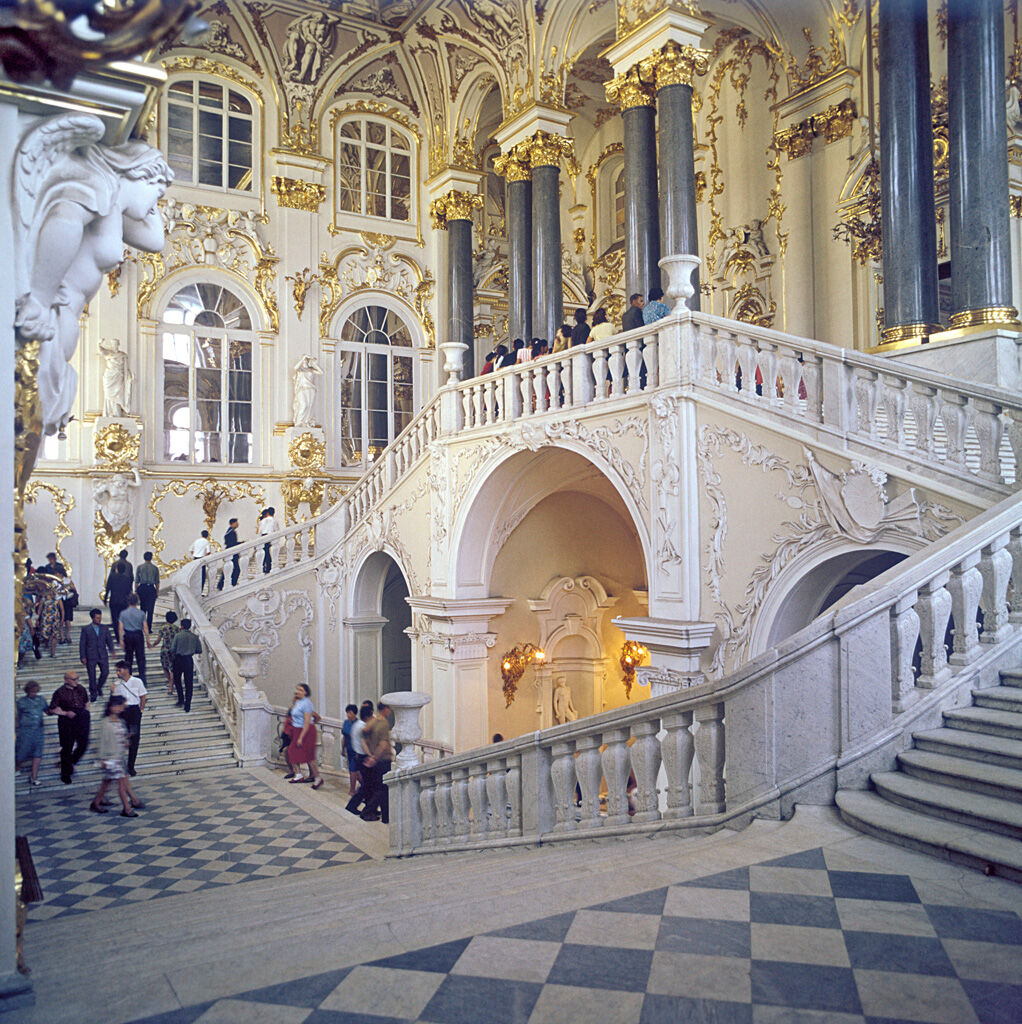
Inside the Hermitage Museum
Catherine II's primary aim in purchasing several collections of works of art was to decorate the Winter Palace. As the number of quality works grew, the palace quickly became an art gallery. It was Alexander 1st who officially designated the Hermitage as an imperial museum. Today, the Hermitage Museum is St Petersburg's greatest tourist and artistic attraction. The 5 buildings house around 400 exhibition rooms containing a total of some 3 million works of art, making it one of the most famous painting museums in the world.
The Hermitage's collection is extremely impressive, bringing together works from the Stone Age, Eastern Classical antiquity, Greek antiquity, Roman antiquity, the Italian Renaissance, works from the 18th, 19th and 20th centuries, objects from Russia's imperial palaces, collections amassed by former Russian emperors, Islamic art objects, Russian art objects, and so on. The most famous painters are exhibited at the Hermitage, including Leonardo da Vinci, Raphael, Michelangelo, Monet, Renoir, Van Gogh and Picasso.
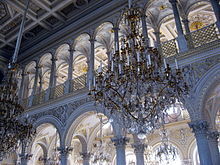
One of the Hermitage exhibition rooms
During the Second World War, Hitler's army attacked the city of St Petersburg, threatening to destroy everything. To protect the works in the Hermitage Museum, the museum's staff moved the collections to the cellars for safekeeping. Some works were sent out of town. Although the buildings were severely damaged during the siege of the city, the collections remained intact. The damage caused by shells and bombs has since been repaired.
